|
Some common practices,
myths and mistakes on decompression.
Presented below is a collection of concepts,
common practices and deco model behaviors that are often overlooked
or miss understood. The topics shown were selected based on comments
in current discussion groups.
Please note that these topics apply to mixed gas decompression
ascents. NDL dives have other considerations not shown.
First
stop = 80% ATA of depth ?
Some tech divers like to use
simple rule based systems to create their deco schedules. These are
often called Ratio Deco, or Deco on the fly. They are comprised of a
simple formula that can be used in-water but also require other
specific settings such as mix and depths. One of these rules is used
to calculate the first stop depth as: "First stop = 80 % of ATA
depth".
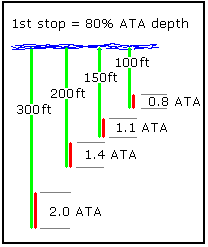 |
Does this look
right? The first stop distance gets smaller on shallow
dives?
The 100 ft dive has the smallest gas load and
requires the least amount of decompression. However, the x%
first stop rule causes this 100ft dive to commence
decompression stops almost at the bottom. The distance
permitted from bottom to first stop is not sufficient. The
same can be said for the 200ft example, and all depths in
between. The problem is the deco schedule commences too early
in the ascent:
The 80% value is valid at 300ft only.
At other depths, the 80% value goes out of scale, and gives an
invalid first stop dimension.
|
The x% rule was originally designed for use with 270 to
300ft dives at WKPP but needs a correction to remain in context with
any other depth. The efforts to extrapolate the rule base from the
300 ft dives to all other depths, have failed to address the change
in scale required.
A better solution to the "simple rule" first
stop:
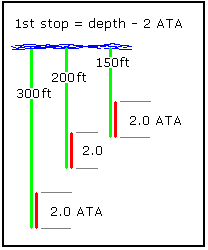 |
There is an easier
"simple rule" that approximates this first stop depth quite
accurately.
The first stop depth is related directly
to the pressure change from the maximum dive depth (distance
from bottom). The first stop location is primarily to limit
and prevent bubbling quantities and sizes from growing large
early on in the ascent.
For most dive parameters, the
fastest tissue cell gas loads begin to stabilize after 10 or
15 minutes. The dimension of the first stop (distance from
bottom) will be very similar across many decompression dives.
This approach uses the same first stop distance for
all decompression dives. It corresponds nicely with many
planning tools and with validated table data in use today.
|
Note: All these simple "one variable" based rule
systems will fail at some point. Decompression stop placement is
more complex than a single variable or constant can account
for.
Warning: All these methods are approximations,
offered for quick check purposes only, and require additional rules
(bottom mix controls, depth ranges, deco gases req'd, etc) . They
are not to be used as substitutions for actual computed plan
dimensions. Simple rules like these cannot account for all dive
variables.
A simple comparison of first stop
depths:
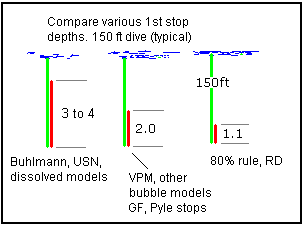 |
The first stop depth in
older, original and dissolved models, is typically 3, 4 or 5
ATA's from the bottom. These models have performed millions of
successful dives.
In the 90's, deeper stops became more
wide spread. Pyle stops, WKPP, Gradient Factor models, and
then Bubble models all produce plans with stops that typically
started at around 2 ATA from bottom. All these methods
reported better post dive feelings, and the ability to reduce
overall decompression times.
The first stop distance
for the Ratio Deco 80% method, when used on dives of 200ft or
less, will produce the deepest of all first stop depths. This
method does not have any benefit over those at 2 ATA.
|
Slow ascent off the bottom ?
Q. What is the
right ascent rate when leaving the bottom?
A. Any rate will work,
however....
The diver must use the rate as planned. This
area of the ascent is critical in the timing and gas load. Any extra
time spent in this deep section, will incur additional gas loading.
If a diver was to ascend slower than planned, then the diver will
incur a bigger gas load than originally calculated and require
additional deco time to match it.
Bubble models will account
for a fast ascent and the potential bubbling. They will stop your
ascent before bubble quantity / size becomes a problem (this is the
primary function of bubble models).
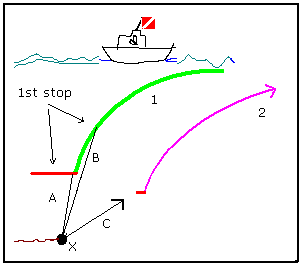 |
If the ascent rate is A,
then the First Stop is encountered at a deep location.
If the ascent rate is just right for the conditions,
it will be B. In this case the diver has carried out just
enough deco during the ascent. The ascent was rate was perfect
match to the conditions. Hence the dive program will display
the first required stop higher up the curve.
If the
diver is slow off the bottom (slower than planned) as in C,
then the diver incurs more on-gassing, and requires a new
ascent schedule (2).
Note: the ascent C is perfectly
OK, but the dive must be planned using the slow ascent
rate. |
Limitations of each ascent above are set
by:
A: The fast ascent rate and bubbling
limitations.
B: The modest ascent rate and bubbling
limitations.
C: Increased bottom time leads to
increased deco requirements.
Adding deep stops ?
The risk of adding a deep
stop onto a bubble model plan, is over staying in the deeper
sections of the dive. This will require additional decompression to
compensate. A Bubble model will provide all the necessary deep
stops.
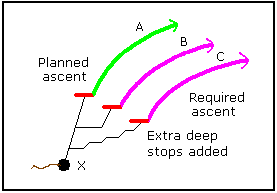 |
When an extra deep stop
is added to a bubble model plan, it becomes an actual multi
level dive. The extra stop is really an extension to the
bottom time and the diver incurs increased gas load. There is
no avoiding this situation. A diver will on-gas from the
highest ambient pressure - precisely what happens with these
extra deeper add on stops.
|
This type of extra deep stop has no benefit. The diver needs
to rise in the ascent sufficiently to create a pressure gradient to
commence off gassing (usually 1.5 to 2 ATA off the bottom). Adding
deeper stops will either make additional gas load and more required
deco, or no gas exchange will occur (fast cells are equalized at
ambient pressure) and the stop is just wasted time.
Please note that these topics
apply to mixed gas decompression ascents. NDL dives have other
considerations not shown.
Super
slow last ascent ?
A common practice is the very slow
ascent from last stop up to the surface. It is often said that this
super slow ascent greatly improves the divers post dive feelings.
This practice is perfectly OK, because...
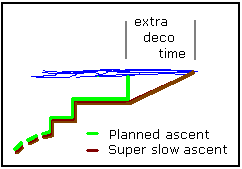 |
The decompression plan
shown here is the green line and the super slow ascent by the
diver is the brown line. The deco program actually ignores the
selected last ascent rate setting. When the program clears the
last ascent to surface - it considers all deco requirements as
complete.
The super slow ascent has in effect extended
the last stop time by a significant amount. The passage from
last stop to surface is extra time. i.e. 5 minutes extra deco
on O2. |
Note: It is perfectly OK to perform this
extended time & super slow ascent.
Q. Is it the ascent,
or the 5 minutes extra deco that helps a diver to feel better?
A.
Both are beneficial and they compliment each other. Using O2 deco
for an extra 5 minutes probably contributes the most, just as it
does on the surface and post dive.
Q. Why do deco programs
ignore the last ascent rate set?
A. They need to prevent cases of
inadvertent skipped deco. If the program was to consider and include
the slow last ascent, the time to surface shown would be a lot
earlier. The diver would then be obliged to carry out the slow
ascent on all dives. In real life the diver might do some ascents at
the regular ascent rate, and therefore the diver will inadvertently
skip over a large amount of required deco.
20ft
/ 6m last stop ?
The last deco stop at 20ft / 6m. This
works well for 100% oxygen deco only.
 |
The 100% oxygen gas has
the unique ability to deliver a 0% ppInert at any depth.
For all other mixtures, the ppInert reduces as the
diver ascends. The reducing inspired ppInert gas is the
driving force in the off-gas process.
|
The 20ft / 6m last stop is a benefit only to divers using
100% oxygen for decompression gas. The use of any other deco mixture
requires the continued reduction of inspired ppInert (the diver
ascends) to drive the off gas procedure.
Divers using Air,
32%, 50%, etc. should continue the stepped ascent to the surface and
include the normal 10/15ft or 3/4.5m last steps.
Extended & Accelerated stops
This shows
the Extended stop and Accelerated stop procedures applied to the
basic decompression ascent and how they modify the plan. The
accelerated stops are also known as "Pushing the Gradient", and
"Fast helium".
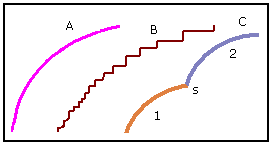 |
The ascent curve in A
shows an ideal ascent for a single gas decompression curve.
The ascent shown in B is the normal decompression of
stops and steps in normal use. We have forced decompression
into blocks of time and distance that suit our needs.
|
Ascent C shows a multi gas decompression curve. The diagram
shows the junction (s) between deco mix 1 and 2. With each mix, the
ascent rate slows in response to the reducing ambient pressure, and
the reducing gradient between tissue ppInert and inspired ppInert.
The off-gas rate is refreshed with the new mix, and increased
ppInert gradient.
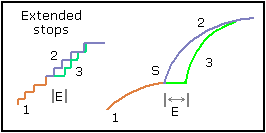 |
Extended Stop: The
diver elects to stay longer at the switch point (s) to carry
out the Extended stop (e). Off-gassing continues and will
reduce the required stop times at adjacent levels. The
advantage of continued use of the Extended Stop is limited by
the high ambient pressure. The required ascent after this
extended stop will steepen initially (3), but will return to
the base line as the ascent continues. |
The extended
stop works in combination with the gas switch and reduced
ppInert. It cannot be applied in the deepest sections, due the
risk of increased gas loading: see Adding Deep Stops
. |
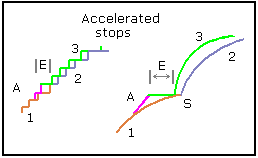 |
Accelerated Stop
("Pushing the Gradient"): This procedure permits the diver
to violate the base line ascent ceiling (a). During this
period, the off-gas gradients have increased and fast inert
gas (helium) responds well ("pushed the gradient"). The diver
then reaches the mix switch point (s) and applies the Extended
stop procedure (e). The brief period of higher off gas rates
(a), work in conjunction with the Extended stop (e). At the
completion of the Extended stop, the diver is now ahead (3) of
the base line curve (2) and will complete the decompression
faster. |
The additional risk to the diver is the
period during (a), in which the Pss is increased briefly. The fast
transfer rates of helium can respond quickly to the increased
off-gas gradient.
The Accelerated stop procedure shows that
existing models and calibrations can indeed calculate the "fast
helium concept". In the past, models would not permit the diver to
violate the stop ceilings to take advantage of this condition.
Deco on helium mix
Some trimix
divers will use a decompression gas made with a trimix or heliox
blend. They often report improved results in post dive conditions
over traditional EAN based deco gas. The diagrams shows how that
improvement is achieved and shows the gas loads during decompression
for both the EAN and mix based deco gas.
 Tissue Pressures
Tissue Pressures
Using EAN 50...At
the switch onto 50%: No inspired He, so the helium
gradient has been maximized, leads to rapid off gas of He for
the rest of the dive. The N2 inspired component is virtually
unchanged during the switch, and the off gas rate of N2 is
controlled by ambient pressure reduction alone. N2 off gas is
slow.
Using EAN 50...At the switch onto 100%: The He
off gas gradients are maximized during the entire time from
the switch to 50%, and this will continue through the 100% O2.
The He tissue pressure levels are very low. N2 tissue
pressures are high. N2 off gas rates increase during the 100%
O2 period, though it will take some time to
achieve.
Using 50/50...At the switch onto 50%:
The helium gradient has not changed - still inspiring up to
50% He, and the off gas rate of He is controlled by ambient
pressure reduction alone. No inspired N2, so the nitrogen
gradient has been maximized, leads to increased off gas of
dissolved N2 from tissues.
Using 50/50...At the switch
onto 100%: The N2 off gas gradients are maximized during
the entire time from the switch to 50%, and this will continue
through the 100% O2. The N2 tissue pressure levels are at
modest levels. He tissue pressures are high. He off gas rates
increase during the 100% O2 period. The benefit of "fast
helium" can now be utilized to off gas a lot of He in a short
time..
|
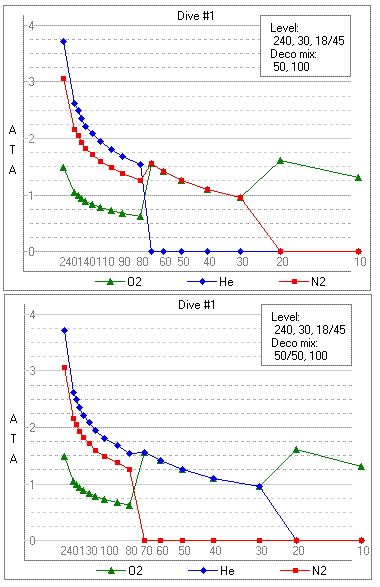 Partial Pressure values
Partial Pressure values
These two graphs
show the pp values for a sample dive across the various stops.
The top graph has 50 EAN, the lower with graph with
50/50.
Using EAN 50
Note how the N2 (red)
ppInert pressure remains high through the dive. At the switch
onto 50% mix (70ft), the N2 pp has increased to the level
experienced several stops deeper (earlier). The effectively
brings N2 off gas rates to a halt. N2 off gas later resumes
several stops further up the ascent.
The Helium has a high
gradient driving its off gas from mid way through the
decompression.
This gas choice places the emphasis on
getting the Helium out.
Using 50/50
Note how
the N2 (red) ppInert pressure drops to 0 at the 50% mix switch
point. This give the slower Nitrogen the highest gradient
possible to off gas for all of the remaining decompression and
ascent.
The Helium gradient is relatively consistent
reduction through the ascent and deco mix changes. The faster
rate of helium allows the off gas process to keep pace with
the ascent, and is driven on ambient pressure reduction alone.
At the final stops, when 100% is used, the helium off gas rate
recieve a boost from maximized inspired inert gas partial
pressures.
This gas choice places the emphasis on getting
the Nitrogen out. |
The difference is the amount of
nitrogen remaining after a dive. Both approaches use 50% O2, but
with a different inert gas. Remember that the purpose of deco is to
remove bottom mix from our bodies. The rates for off gas is
controlled by the inspired mix and pressure gradients between each
inspired and dissolved inert gas. Any inert gas we breath during
deco will slow this process. i.e. if we breath He in deco, it slows
the off gas of He.
Q. What does helium deco achieve?
A.
The 50/50 (or 50/25) is used to remove more N2 earlier! It
does not remove He faster! In fact a diver retains more He up to the
switch onto 100% O2. Only then does the "Fast helium" off gas rates
used to complete the deco.
Q. Why do I feel better using a
50/50 (or 50/25) mix for deco?
A. The diver has reduced N2 levels
upon surfacing.
Q. I can shorten the required deco times on a
50/50 plan. Why?
A. This is "Pushing the Gradient" See the
Accelerated Stops procedure above.
Q. Helium is fast, so breathing
helium in deco should speed deco up?
A. The deco process is to
remove bottom gas from our tissues. Deco gas is normally not
absorbed. Breathing He during the deco inhibits the off gas of
He.
Q. The plan gets longer when using a trimix deco.
Why?
A. Breathing helium slows the off gas of helium, so more
time is required to achieve the same reduction in tissue pressure
levels. In a trimix dive, the Helium component is the dominant
factor during the bulk of the deco. The diver has set a margin of
safety or conservatism value into the program, and the program is
carrying this out.
Q. Still not sure?
A. Breathing back
gas is the slowest deco (no pp inert gradient to assist). Breathing
O2 gives the fastest deco (maximum pp inert off gas
gradient).
Note: Some of these diagrams
are not to scale. Exaggeration has been applied in the areas of
interest.
|
|